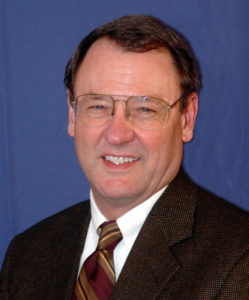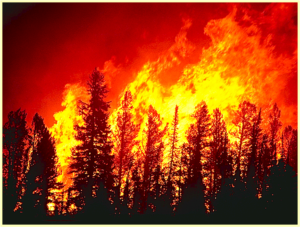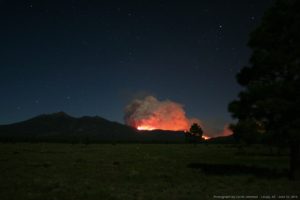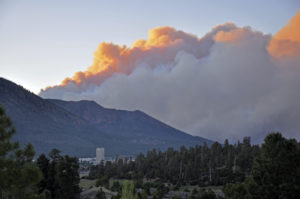Unplanned wildland fire is now the primary treatment method used on public lands in the Western United States, says the U.S. Forest Service’s recently retired deputy chief.
Jim Hubbard isn’t suggesting that is the best way to manage the nation’s forests, but it is the reality of what is happening and likely will continue happening for the foreseeable future.
Hubbard, who retired as deputy chief for state and private forestry in January, recently sat down with Treesource to discuss his career and the state of firefighting and land management on forests throughout the West. His duties as deputy chief included directing fire and aviation, as he did previously for the Department of Interior and during 20 years as the Colorado state forester.

Over those decades, everything has changed for public land managers and wildland firefighters, Hubbard said.
As a region, the West has seen higher average temperatures, lower humidities, less fuel moisture and longer fire seasons. Fire seasons are 70 days longer than they were 20 years ago. And every year, more people have moved into the forests as developments stretch out of valley bottom communities and into the mountains.
“So we have a forest that’s more ready to burn in a severe way, and more people potentially at risk from those burns,” Hubbard said. “All of that demands real attention to how you manage the land and how you protect the people and the developments. And most importantly, how do you make sure those firefighters you’re sending out to deal with these situations are safe?”
Hubbard got his education during 35 years in Colorado, the last 20 of which were as the state’s chief forester.
Wildfire played virtually no role in Hubbard’s early career in Colorado, which was known in the firefighting community for its “asbestos forests.”
“Colorado, like a lot of the West, has forests created by disturbance: insect, disease and fire,” he said. “Colorado’s forests were 120 years old-plus, and they were starting to decline in vigor. Just because of their age, they were starting to decline in fuel moisture.”
But what set off the wildland fire explosion were the climatic conditions, Hubbard said. When those age-stressed forests were hit with year after year of crippling drought, they started to burn.
“Now, when you have lightning strikes, and Colorado has plenty, the forest burns,” he said. “Before, if a strike did start a fire, it went out or it didn’t spread. Those forests just didn’t burn. Now, they burn – and every year, burn in spectacular ways no one has seen before.”
Hubbard was the state forester when a wildfire erupted on Storm King Mountain outside Glenwood Springs one July afternoon in 1994, killing 14 firefighters and providing a deadly benchmark for the wildland firefighting community.

A few years later, in 2002, he watched as the Hayman fire burned across 18 miles in one afternoon, to the edge of Denver, waking Front Range municipalities to the realities of wildland fire in the modern era.
“We had a new focus as a state agency,” Hubbard recalled. “The priority was on land treatments, community protection and emergency response. Life got a lot more complicated, and that has only increased in the years since.”
Now, in fact, unplanned wildland fires are the primary way that public lands are altered – not by logging or recreational development or even by restoration projects. Wildfires have the upper hand.
Fires also control the Forest Service’s budget, as Western congressional delegations know all too well. The administration proposes a budget that calculates the current year’s firefighting budget based on the 10-year average of suppression costs. But since that cost has been going up every year, firefighting commands a larger and larger share of the agency’s overall budget.
And each season, when firefighting funds run dry, other programs are forced to “give back” some of their funding to avoid a deficit in the fire account. Congress won’t approve extra dollars, post-fire. The agency must live within its budget.
“More than half of the total Forest Service budget goes to firefighting, and that’s probably going to continue,” Hubbard said. “After 10 years of doing that, it has eroded all of the agency’s program capabilities.”
*
And that’s how Hubbard comes by his call that foresters acknowledge the overwhelming presence and role of fire – and use it to their advantage as land managers.
Here’s his pitch:
“One approach, particularly in the wildland-urban interface where trees and homes are mixed, is aggressive suppression,” he said. “But in other places, particularly in the northern Rockies, we need to put fire back into these ecosystems that are fire dependent and fire adapted.
“We need to pay attention when a wildfire breaks out and manage our suppression response to meet our forest management goals.”
That, of course, means managing a fire in a different way, Hubbard said. “And everyone has to be involved in that decision, because with any longer-duration event, sooner or later that fire might just do some things you don’t want it to do. If everyone isn’t on board, you don’t try it. If everyone is on board, you have to be very careful.”

Fire science, led by researchers in Missoula, Montana, have made significant strides in the past two decades that provide firefighters with predictive modeling tools that can, under the right conditions, make it possible to “manage” an unplanned wildfire.
“We have better tools,” Hubbard said, “but not everybody has been exposed enough to the science to understand that we are managing a fire rather than actively suppressing it. We’re not even close to the level of understanding that is needed with the public.”
Hubbard advises starting at the local level: with elected officials, fire departments, ranger districts and civic leaders.
“The local fire department has a legal mandate to fight fires,” he said. “We need their agreement if we’re going to do things differently on federal land. The elected officials have constituents to worry about, and they’ll raise concerns about human health and wildfire smoke, so you’ve got to consider that as well.”
The conversation has to happen pre-season and pre-incident, Hubbard said. “You’ve got to explain things in a way that private citizens have some understanding of what might happen and of what kind of decisions fire officials might make. It all starts right in that local community, with well-informed decision makers and a well-informed public.”
Those conversations lead to the prioritization of firefighting efforts during the thick of the season, Hubbard said. They also lead to collaborative efforts that recognize the need to find new ways to protect the forests that provide so many Western communities with their drinking water.
Increasingly, albeit slowly, Hubbard has seen communities step forward and lead watershed restoration and protection efforts in their own backyards – forming collaborative groups, finding creative ways to finance forest thinning and prescribed fires, educating the public about the relationship between their drinking water and forests and wildfires.Hubbard likes what he’s seen in Ashland, Oregon, where the mayor mobilized the city council, government agencies and the community to draft a plan for thinning the forest that sits atop the municipal watershed, thereby protecting the community and its sole source of drinking water from unplanned wildfires.
“That effort is showing terrific promise,” he said.

He’s similarly enthused about the approach taken in Flagstaff, Arizona, where the community approved a $10 million bond issue for forest restoration in the city’s watersheds.
Flagstaff residents had seen the consequences of unplanned wildfires when torrents of water and debris flooded entire neighborhoods after the Schultz fire in 2010. A subsequent study showed a potential $1.2 billion disaster should the same magnitude of fire and floods occur in the watershed directly north of downtown Flagstaff and the Northern Arizona University campus.
“It’s not easy,” said Hubbard. “It takes the right kind of leadership with the agencies. People have to be willing to come to the table and share decisions. For many agencies, it’s a fundamental cultural shift in the way they do business.
“But I think we’re ready for it, and I think we are going to see more of these community fire and watershed protection projects.”
It’s never just one agency that galvanizes a community, he said. “It takes everyone. You need the right kind of local leadership and the agency managers as well. And then they usually need a little sprinkling of something else: a little bit of money that they didn’t already have.”In Ashland, the Forest Service provided guidance and money, while The Nature Conservancy led the collaborative process. In Flagstaff, voters approved the bond issue that funded the watershed restoration work, while the city and Forest Service and state added dollars from their own budgets for additional thinning and prescribed burning projects. On Colorado’s Front Range, water utilities have contributed millions of dollars that the Forest Service has, in turn, matched.
“How you write the recipe is always a little different,” Hubbard said.
If there is enough forest restoration work in the priority watersheds, then the inevitable wildfire might just run into the thinned areas and lie down, giving firefighters a chance to stop the flames before the ground is intensely burned.
Where a fire occurs deeper into the mountains and forests, the pre-planning and prioritization may allow firefighters to “steer” the fire into forests that need burning and that pose no immediate risk to people or infrastructure.
“Hopefully, there are times when we can manage the fire in a way that it can do the right kind of work for us,” Hubbard said.
“We are not going to solve this anytime soon,” he said. “We need to find a way forward that represents progress. We are not going to get any sudden infusion of money. We are just going to have to work through this together, because it’s going to be a long time before we get to where we need to be.”

Hooray for Sherry Devlin! This article is excellent. Millions of people need to read it and think about what it says.
My compliments. Extremely well done.
Yes, some will say, “…easier said than done”, but sooner than later we are going to have to develop the skills necessary to “steer” fires (read, manage better unplanned ignitions) and develop the biomass markets (e.g., nanocellulose materials from hazardous fuel) that eventually will enable “steering” to take place with a reasonable chance of success.
As I have said many times, this is a campaign requiring patience over an extended time period. When the National Fire Plan was developed, the conversations were so very similar. But, we did not have the task relevant maturity (TRM) (read, ability and willingness) at a level needed to begin the campaign. That was 16 years ago. I can only imagine what our “steering” skills would be by now if we would had done what we concluded then, was needed to do.
We are at a crossroads. We must take the first steps, albeit small and very measured, to restore fire to the landscape. Or, continue as is and eventually simply become a fire service. To begin to use fire more as a restorative tool, we have to be quite corporate; no small feat. Simply put, we all have to be “all in.”
Interestingly, we currently have a strategic framework in place to begin “steering.” It is called the “cohesive strategy.” Prior to 2000, we had the first “cohesive strategy.” Then the “National Fire Plan.” My point: We do not lack a vision to proceed. Now, we simply need to ask ourselves do we have the TRM to take those small, measured steps. If not, what would it take? Not taking the small steps, that eventually WILL become strides, is not an option in my view.
At my last Forest Service National Leadership Council meeting in December 2015 (before I retired), I was convinced the agency was ready to take the beginning steps of this campaign. Again, something pulled us back.
We are indeed at a crossroads. Thanks for this piece. We need many more and a cohesive communications campaign to help describe the dilemma and what can be a terrific opportunity to save lives and property and bring landscape scale conservation back into the natural resources management portfolio.
Very respectfully,
Sherry, thank you and Treessource for sharing such a wealth of information. Director Hubbard and his team have started an awareness and educational program about forest health and treatment that can not only protect important watershed but also benefit all outdoorsman and so many different forest product industries alike.
The changing climate is only a small part of the problem. The real problem is the lack of Forest management on Federal lands because of Environmental groups preventing treatments on lands by appeals on Management Plans that they disagree with. Most are uncalled for just because they don’t like tree harvesting. The NEPA management act had good intent but gave them too much weight. Congress needs to act and give the power back to the Forest Service and Foresters to manage the Forest in the CORRECT WAY!!
I spent 35 years in the FS. That was just when NEPA was past and our hands were tied!! National Forests were set up to provide services for the American Public and one of those is harvesting timber which Foresters go to College to learn the correct way to do that not a bunch of Environmentalist that don’t care how they treat the Forest!
Nobody wants to admit that. Thats why we are having a lot of large fires! Put the blame where the blame belongs at that Environmentalist feet!!
Call a Spade a spade!